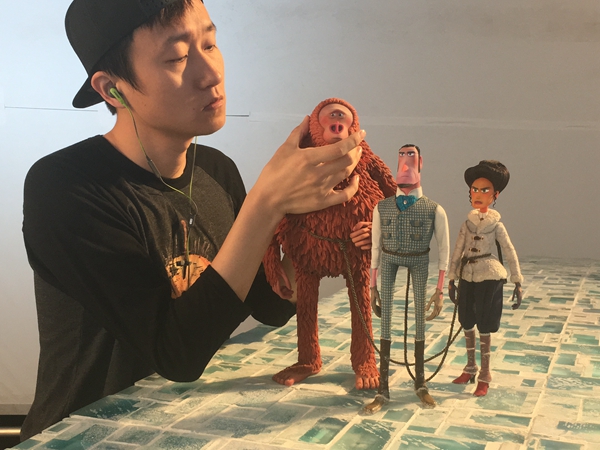
Another animator Xu Ning adjusts the puppet characters of Missing Link, while working at Laika Entertainment, an animation studio in the United States in 2017.[Photo provided to China Daily]
Contributors on board
Wang's team members, most of whom are in their 20s, are from varied educational backgrounds, such as environmental or industrial art and computer science, but they all share an identical passion for handcrafting. "It's a young team. We are all on a journey to explore unknown fields and improve ourselves," says Wang.
The domestic industry does have a lack of experienced and talented figures who can help young practitioners progress efficiently, according to Wang.
In this aspect, Xu believes he can lend a hand. He left the US animation studio in 2018 and came back to China, aiming to share his knowledge and experience.
Xu has opened his own channel on the video-sharing platform Bilibili, where he uses short videos to offer a behind-the-scenes look at stop-motion animation techniques and plans to release tutorials that he hopes will attract newcomers to the art.
"I want to cultivate more domestic stop-motion animators. I believe stop-motion will have a stronger presence," he says.
He is confident in the future development of Chinese stop-motion animation, as the country boasts such traditional art forms as shadow play and puppetry, similar to the animation form. Moreover, the Shanghai Animation Film Studio had produced The Magic Brush, Tale of the Effendi and many other classic, well-made animated works, using the cinematographic technique decades ago.
"Anyone who owns a phone or a digital camera can start working with the technique. You can have lots of fun here," says Xu. He adds that in China's fledgling stop-motion film industry, practitioners are willing to help one another to move forward and be seen by investors and a larger audience.
Liu Di, a stop-motion animation director, points out that, currently, the industrial chain that supports the craft is not mature enough.
He adds that few universities in China have set a major for the medium to cultivate more professional talent.
"However, once the animation type becomes widely received by the audience, all these problems will be readily solved," he says.